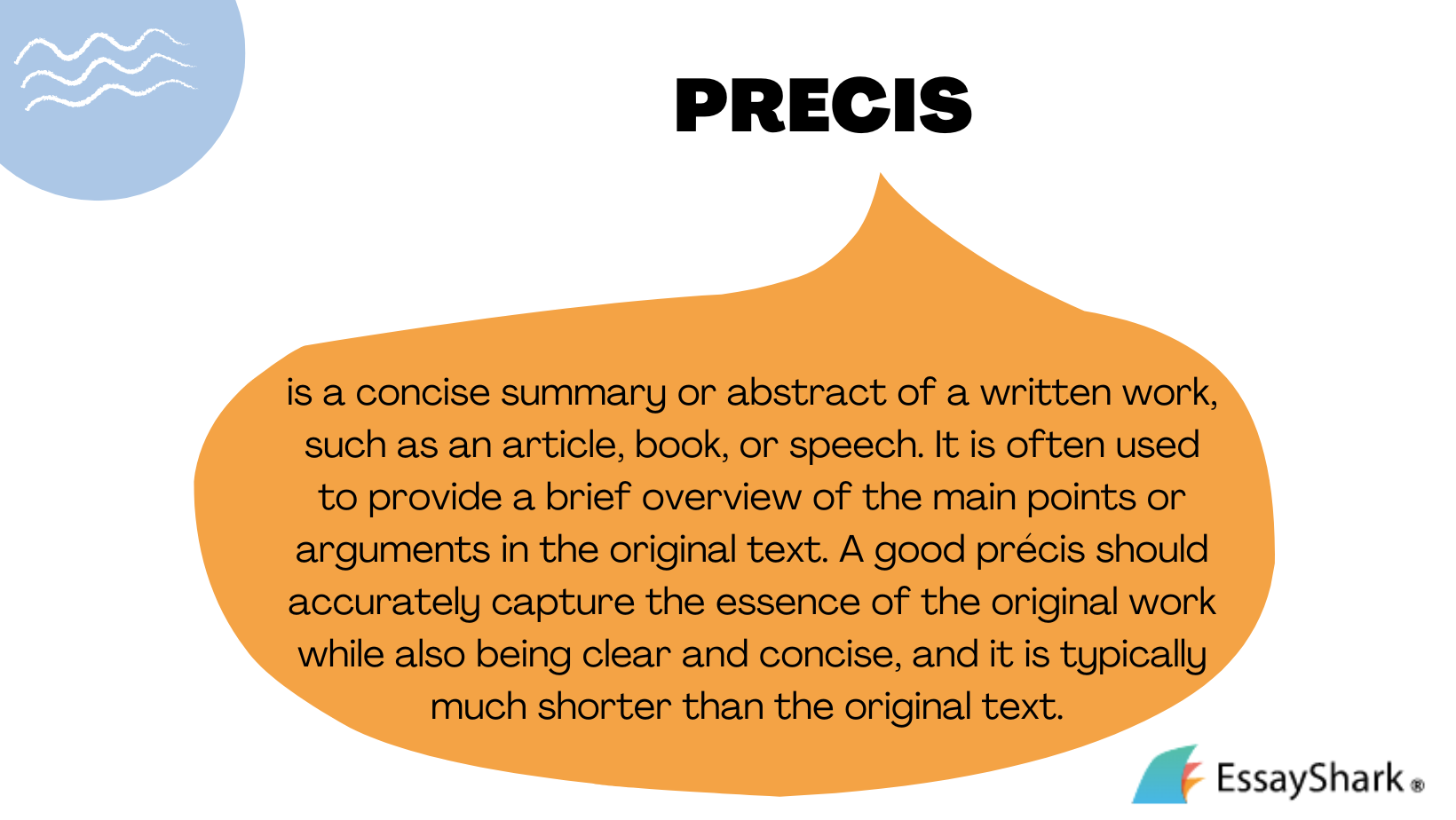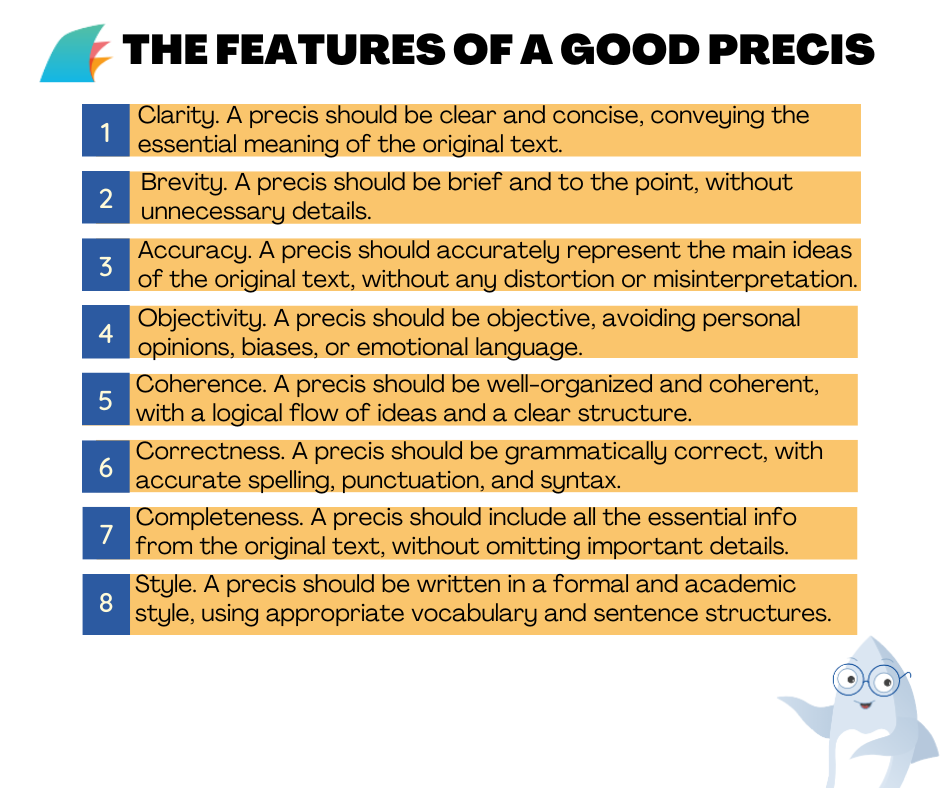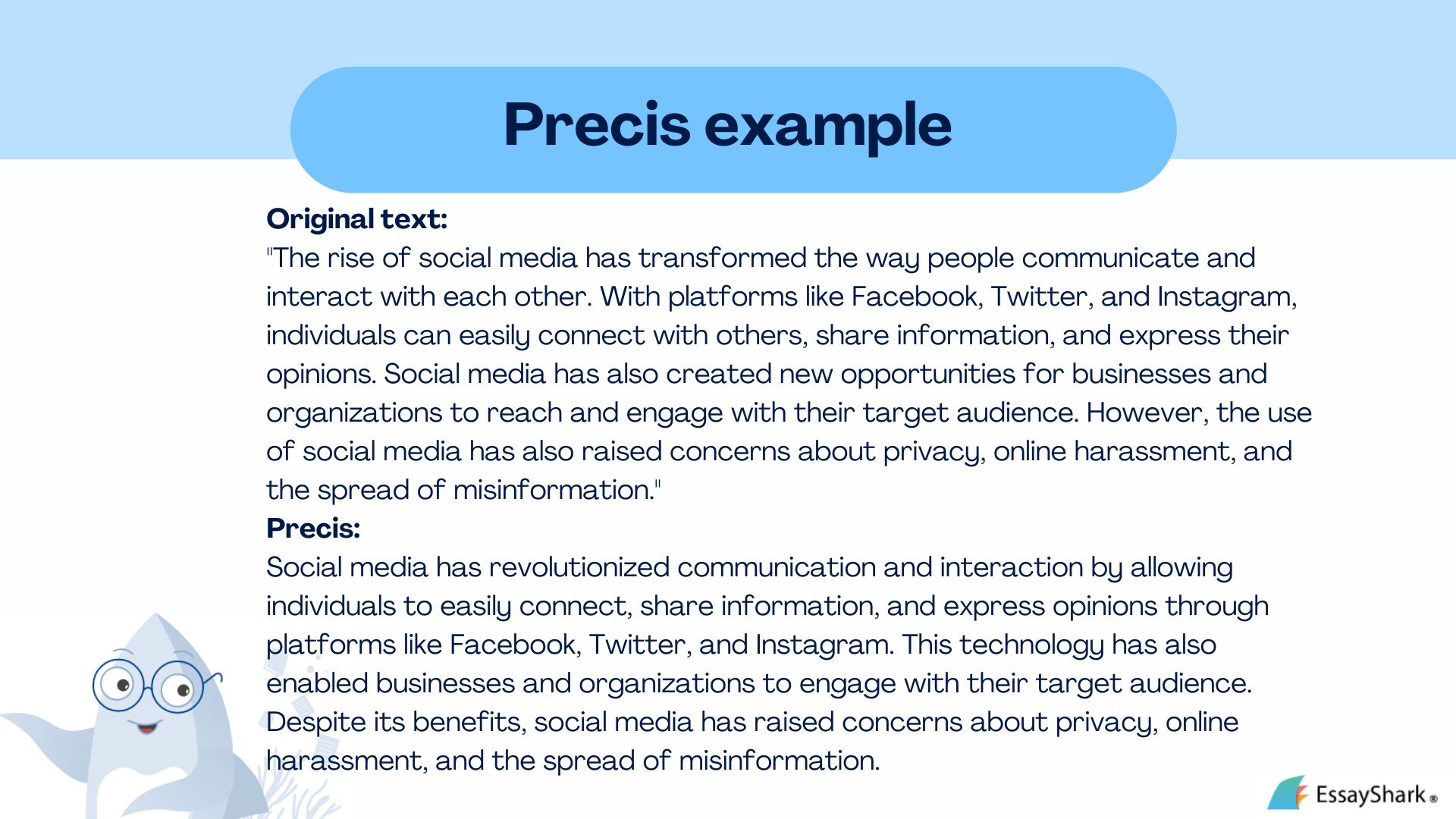Does the word “precis” make your palm sweat? Do you hate this type of assignment because the grade for it always spoils the GPA? EssayShark rushes to the rescue to reveal the secrets of writing a precis. These tips will be handy for taking an exam where you should deal with precis writing.
Wise professors say that students should write as many cheat notes as possible. But, they certainly aren’t allowed to use them during the exam. So why waste your time on these useless little sheets of paper? The answer might surprise you. Writing the cheat notes, actually, helps you to learn and memorize information.
Every time you write something down, your brain processes the note better than when you simply read the text. Thus, a precis is a great way to get prepared for your exam. We promise that this method will be much more effective than endless cramming. In the article below, we’ll share with you some secrets and tips on how to write a precis and get a straight A for your exam!
Table of contents
What is precis?
This difficult task requires you to be able to isolate important (essential) information and select lexical and grammatical means to briefly and coherently convey the content of the text that you will read. Understanding the main text and comprehension of its idea is important as it makes it easier to write precis and saves time.

The condensed precis is a retelling of the main content of the original text; however, this is not a simple retelling but a new text based on the one you have read. The precis should be short in form but rich in content and briefly and generally convey the primary text’s information.
Compressing the text, you must remember that the new text you create must reflect the author’s primary thoughts, and the presented event’s logical sequence must be observed. In addition, distortions of the author’s views are unacceptable. The precis should be the original text.
Briefly presenting the text you have read is difficult, so we recommend that you read the text attentively. You can use various methods of compression while working on it.
How to compress the source text
The degree of compression of the source text in the precis may be different, but it is not the degree of reduction of the text that matters, but whether you can transfer the contents of the source text in a compressed way. The requirements for a condensed precis may not specify the maximum allowed number of words, but the presentation should only reflect part of the content of the source text (in this case, the written text will be a detailed precis). We recommend the following range: 100–200 words.
Take care to ensure that all the micro-topics of the original text are preserved in the precis. Recall that the requirements for a concise precis say that the source text contains 3 micro-topics. There are various approaches to determining the methods and techniques of text compression – linguistic and content.
The primary content forms of compression can be called the following:
- division of information into primary and secondary, exclusion of irrelevant and secondary data;
- curtailment of the initial information due to generalization (translation of the particular into the general).
Compression techniques
1) Reducing of:
- individual parts of the sentence;
- homogeneous parts;
- repetitions;
- one or more synonyms;
2) Replacement of:
- homogeneous parts with a generalizing word;
- sentence fragment with a syntactic synonym;
- direct speech with indirect one;
- a sentence or its part with a demonstrative pronoun.
3) Merge:
- Of two simple sentences. As a rule, it is accompanied by a replacement or reduction.
- in the description – of the subject and its significant features;
- in reasoning – of general provisions, thesis, arguments, evidence, and conclusion.
Preliminary notes will help you to build the work logically, based on which a detailed plan is drawn up. Drawing up a project is a fundamental technique to writing a good precis. It is a detailed outline that will not allow you to remove information essential for the content from the text; subsequently, this will help preserve the sequence and connectedness of the parts.
The main rules of precis writing

The main rules of precis writing are:
- Understand the original text. The first step in writing a précis is to read the original text carefully and understand its main idea, argument, and supporting details.
- Identify the main points. Identify the main points of the original text, including its purpose, thesis, key arguments, and supporting evidence.
- Use your own words. Express the ideas of the original text in your own words while maintaining its essential meaning and tone.
- Use third-person singular. Write in the third-person singular, using neutral language and avoiding personal opinions or biases.
- Keep your precis brief. It should be a brief summary of the original text, usually one-third to one-fourth of its length.
- Focus on the essential info in the original text and exclude any extraneous or irrelevant information.
- Stick to the logical order. Maintain the logical order of the original text, including its main arguments, supporting evidence, and conclusion.
- Check for accuracy. Check your précis for accuracy and make sure that you have not distorted the meaning of the original text.
- Revise and edit. Revise and edit your précis to ensure clarity, concision, and coherence.
Steps for writing a precis
- Read the original text.
- Formulate the central theme and idea of the text (what is the text about? what did the author want to say?).
- Fix the sequence of events and reasoning.
- Make a plan of the text, focusing on the micro-topics of each part of the text.
- Choose compression methods for every part of the text.
- Shorten the text, keeping the primary information and all micro-topics.
- Check the semantic and grammatical connection between the parts of the precis and the presence of the original author’s intent.
- Write a concise precis.
- Reread the written text and pay attention to the number of words (there should be at least 100). If the volume is smaller, it is necessary to determine the part that can be expanded and supplement it.
- After checking the precis from the content side, carefully review the text for grammatical, syntax, spelling, and punctuation errors.
- Rewrite a concise precis if necessary.
How to write a precis for your professor: 10 tips
When you compose a precis as your academic assignment, you have to follow some rules. When you write it for your personal use, you can be as free as a bird!
We’ll give you some tips on how to write a precis to get a better grade:
1. Read the text carefully
During the first reading of the text, pay total attention to it, i.e., actively perceive the content of the text, trying to understand the author’s main idea immediately. We recommend that you wait to make recordings during the first reading. As practice shows, the effect of this technique when reading is reduced. It is much more efficient to first focus on the perception of the text, identify the main topic and its micro-topics, the main idea, and correlate semantic parts with each other.
2. Write down the sequence of the paragraphs
Briefly write down the sequence of paragraphs, the course of the author’s reasoning, the chronology of events, and the sequence of descriptions. Subsequently, this will help to draw up a plan correctly and identify micro-topics.
3. Concretize the initial information
Clarify and concretize the initial information, and make additions or changes to the preliminary recordings of the precis. In addition, try to correct the primary plan and check the proper selection of your paragraphs.
4. Stick to the rules of academic writing.
Composing a precis doesn’t require any creative effort from you, but you still have to follow academic rules. No jargon, no contractions, no exclamation marks! And we have some writing tricks about academic papers for you right here.
5. Avoid wordy sentences.
The point of a precis is to be precise. Short phrases and concise wordings are perfect ingredients for your top-level precis.
6. Remain objective.
A precis isn’t the best place for your personal opinion. We’re sure that your thoughts are original and worth attention, but not in this case, okay?
7. Use your logical thinking.
Although your precis doesn’t have to explain or prove anything, it still has to be readable. If your writing is a mix of random statements, you can only dream of a good grade.
8. Create a title for your precis.
Professors always need a title page or, at least, a title. Otherwise, they will be lost in the labyrinth of endless papers and won’t be able to teach you. So, give them a chance to recognize your masterpiece from first sight.
9. Don’t paraphrase – summarize.
A precis isn’t a paraphrased text; it’s more of a summary. Make it short and concise!
10. Check for mistakes.
We restate this tip in every guide, and you still manage to make mistakes! Seriously? Find five minutes to reread your text, and your grade won’t be ruined by misprints and misspellings!
Follow this instruction, and your professor will give you an A for your precis! If you want to write a precis during your exam preparation, we reveal several effective techniques below!
Features of a good precis

How to write a good precis for your personal use: 5 secrets
We highly recommend you NOT to use these tricks when you write a precis for your professor. But you’ll need them if you want to process and memorize a wealth of information in a few days or even in one night.
- Define unnecessary information.
As a rule, you don’t have to memorize examples, lyrical digressions, and statistical data from the educational material. You can read this information once or twice, but you don’t have to include it in your precis. You should instead focus on important facts, names, and dates.
- Use infographics and tables.
These tools are awesome for memorizing. Firstly, creating infographics requires your artistic skills and, thus, your brain works more efficiently. Secondly, when you try to put all the necessary information in small blocks and schemes, you pick out only the most essential details. If you need advice about these techniques, take a look at our guide on how to make good infographics.
- Make a list of abbreviations.
Sure, you can write “WWII” instead of “World War II” or “UK” instead of “the United Kingdom.” You won’t forget the meaning of these abbreviations. Anyway, you’ll be able to find them on the internet. If you create your individual abbreviations, there is always a risk that you’ll forget them in a few weeks or months. So make a list at the beginning or at the end of your precis for all your inventions.
- Don’t omit dates and names.
Dates and names are frequently difficult to memorize, but they are a factual core of your knowledge on a particular topic. Write them down with bright colors; leave sticky notes on your fridge, in the bathroom, on the walls, etc. Train your memory, and your grades will make you proud.
- Create your personal associations.
That’s the most creative approach to memorization of information. Do you remember children’s songs that help kids to learn the alphabet or names of animals? Why not use songs, colorful pictures, and rhymes to memorize the facts about the Civil War or Sigmund Freud’s psychoanalytic theory? Be creative, and find your personal associations!
We’ve revealed all our secrets. You know how to write a precis for your professor and for your personal use. There is one more thing – don’t worry, it’s just a rhetorical precis! Have you ever heard about it? If not, take a look at the instruction below. Your professor can give you this type of assignment at any time!
How to write a rhetorical precis
You need only FOUR sentences to compose a well-structured rhetorical precis. So, let’s see what you should provide in each sentence.
The first sentence: Mention the title of the article (essay), the author’s name, the publishing date, and a paraphrased thesis statement. You can also quote the author’s statement using the words “declares,” “claims,” “suggests,” etc.
The second sentence: Explain how the author proves his point of view (arguments and example). You should stick to chronological order.
The third sentence: Use the statement in order to to define the author’s main purpose.
The fourth sentence: Describe the author’s tone of voice (how he or she connects with the targeted audience).
Now you know how to write a rhetorical precis. As we’ve promised, it’s not that bad. Stick to the instruction, and you’ll be all right!
Precis example

Writing a precis is beneficial from many points of view. You memorize the information easier, save your time during exam preparation, and compose material that will help you to restore your knowledge in a few months or even years. We hope that our tips will make your college life a bit easier. Good luck!








